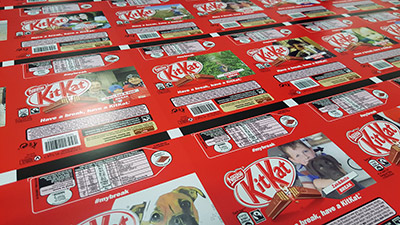Digital printing is the linchpin of most successful personalisation campaigns, although ‘true personalisation’ remains the preserve of the few, and a quandary to many. By David Pittman
2013 is regarded by many as a watershed moment for personalised packaging. This was the year ‘Share a Coke’ took off across Europe, with a network of digital label printers, spearheaded by Eshuis in the Netherlands, helping Coca-Cola get thousands of labels carrying a selection of names onto shelves and into consumers hands.
In reality, the nature of the project and its delivery was a demonstration of mass customisation over personalisation. It placed the impetus on consumers to locate personalised Coca-Cola bottles by having them seek out their own names, or that of a family member or friend. It has since been replicated in other markets around the world and led to further marketing campaigns powered by design software and digital printing hardware. Says, Paul Bates, sales manager at Hybrid Software for the UK, Ireland and global accounts, these represent a realisation of what the hardware and software had been promising for a while.
‘I remember the first Indigo presentations where they had digitally printed personalised information packs for everyone in the audience; that was 26 years ago but the take-up of printing personalised variable data didn’t happen until the ‘Share a Coca Cola’ campaign in 2013.’
He continues, ‘Today, label printers around the world are working with brands to deliver the next personalised printed packaging campaigns. This is a great way to increase turnover and profitability for printers. For years, label printers have printed variable data (VDP) for single colour codes, and today they now realise that with the help of modern software, VDP and personalisation are some of the most powerful tools they have in their business. The folding carton market has been slow to embrace this trend, partly due to the cost issues with finishing and die-making for short-run digitally printed cartons where a die can cost more than the print run, however I feel this is being addressed.’
Packaging potential
Another packaging vertical that has so far proven aloof to personalisation is flexible packaging, with established and complex supply chains and converting process tempering effective delivery of personalisation.
UK-based packaging printer Ultimate Digital has worked on a successful flexible packaging personalisation campaign for confectionery brand KitKat. This allowed consumers to upload a photo via a web portal supporting the campaign, which was then printed onto the product’s wrapper by Ultimate Digital on its HP Indigo 20000.
Chris Tonge, executive director at Ultimate Group, the parent company of the digital printer, notes, ‘Brands encounter issues if we start to treat a pack as one and unique, which creates a lot of headaches through the factory. The real problem with personalisation is how do you cope at the other end of the factory. You can print one million different packs, but then how do you sort them? With KitKat, we took on the fulfilment, and got them sent out.
‘Brands want to pack X number of millions of the same product,’ continues Mr Tonge. ‘With personalisation, the volumes we are talking about are still very small. So we are more likely to have success with smaller brands, who require smaller volumes and are more agile.’
Peter Barton, managing director at Reprocad and the UK representative for Rigoli and its range of water-based inkjet flexible packaging printers, added, ‘There is a huge, hidden, market opportunity, which is being suppressed by minimum order quantities for short run promotions and personalisation of packaging.’
In labels, Mr Bates says, ‘With a big trend for high value short run artisan products, digital label printers are offering a great service with personalised and regionalised product labels.’
For Mr Tonge, the opportunities in personalisation lie in the marketing stories that can be told, with ‘having a name on pack just the start of personalisation’.
‘The way forward is to make the pack the centre of the brand strategy, and have the customer interact with the pack on a personal level.’
This article features in the March/April edition of Digital Labels & Packaging








